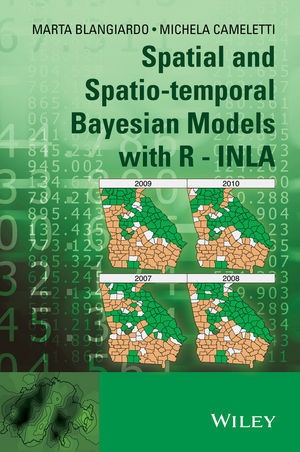Ulteriori informazioni
Informationen zum Autor Marta Blangiardo , MRC-PHE Centre for Environment and Health, Department of Epidemiology and Biostatistics, Imperial College London, UK Michela Cameletti , Department of Management, Economics and Quantitative Methods, University of Bergamo, Italy Klappentext The reference book for spatio-temporal modeling with INLAThe Bayesian approach is particularly effective at modeling large datasets including spatial and temporal information due to its flexibility and ease with which it can formally include correlation and hierarchical structures in the data. However, classical simulation methods such as Markov Chain Monte Carlo can become computationally unfeasible; this book presents the Integrated Nested Laplace Approximations (INLA) approach as a computationally effective and extremely powerful alternative.Spatial and Spatio-temporal Bayesian Models with R-INLA introduces the basic paradigms of the Bayesian approach and describes the associated computational issues. Detailing the theory behind the INLA approach and the R-INLA package, it focuses on spatial and spatio-temporal modeling for area and point-referenced data.The combination of detailed theory and practical data analysis is beneficial for readers at any level. The coding of all the examples in R-INLA and the availability of all the datasets used throughout the book on the INLA website (www.r-inla.org) make an appealing feature for applied researchers wanting to approach or increase their knowledge and practice of the INLA method. Zusammenfassung Spatial and Spatio-Temporal Bayesian Models with R-INLA provides a much needed, practically oriented & innovative presentation of the combination of Bayesian methodology and spatial statistics. Inhaltsverzeichnis Dedication iii Preface ix 1 Introduction 1 1.1 Why spatial and spatio-temporal statistics? 1 1.2 Why do we use Bayesian methods for modelling spatial and spatio-temporal structures? 2 1.3 Why INLA? 3 1.4 Datasets 3 2 Introduction to 21 2.1 The language 21 2.2 objects 22 2.3 Data and session management 34 2.4 Packages 35 2.5 Programming in 36 2.6 Basic statistical analysis with 39 3 Introduction to Bayesian Methods 53 3.1 Bayesian Philosophy 53 3.2 Basic Probability Elements 57 3.3 Bayes Theorem 62 3.4 Prior and Posterior Distributions 64 3.5 Working with the Posterior Distribution 66 3.6 Choosing the Prior Distribution 68 4 Bayesian computing 83 4.1 Monte Carlo integration 83 4.2 Monte Carlo method for Bayesian inference 85 4.3 Probability distributions and random number generation in 86 4.4 Examples of Monte Carlo simulation 89 4.5 Markov chain Monte Carlo methods 97 4.6 The Integrated Nested Laplace Approximations algorithm 113 4.7 Laplace approximation 113 4.8 The package 123 4.9 How INLA works: step by step example 127 5 Bayesian regression and hierarchical models 139 5.1 Linear Regression 139 5.2 Nonlinear regression: random walk 145 5.3 Generalized Linear Models 150 5.4 Hierarchical Models 159 5.5 Prediction 176 5.6 Model Checking and Selection 179 6 Spatial Modeling 189 6.1 Areal data -GMRF 192 6.2 Ecological Regression 203 6.3 Zero in¿ated models 204 6.4 Geostatistical data 210 6.5 The Stochastic Partial Diferential Equation approach 211 6.6 SPDE within 215 6.7 SPDE toy example with simulated data 217 6.8 More advanced operations through the function 226 6.9 Prior speci¿cation for the stationary case 233 6.10 SPDE for Gaussian response: Sw...

